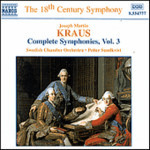
Symphonies, Vol. 3
 $25.00
Out of Stock
$25.00
Out of Stock6+ weeks add to cart
JOSEPH MARTIN KRAUS
Symphonies, Vol. 3
Swedish Chamber Orchestra / Petter Sundkvist
[ Naxos / CD ]
Release Date: Thursday 19 April 2007
This item is currently out of stock. It may take 6 or more weeks to obtain from when you place your order as this is a specialist product.
"These gutsy and supercharged recordings of this little-known music from the Sturm und Drang era are wonderfully illuminated by Naxos' clear and bright aural perspective."
- Robert Emmett Fanfare November/December 2001 Want List 2001
--------------------------------------------------------------------------------
"These gutsy and supercharged recordings of this little-known music from the Sturm und Drang era are wonderfully illuminated by Naxos' clear and bright aural perspective."
- Robert Emmett, Fanfare, November/December, 2001
--------------------------------------------------------------------------------
"The pieces on this disc...are all in this dramatic style, excitingly played by the excellent Swedish Chamber Orchestra. They in clued an atypical Symphonie funebre where all four movements are slow, music written for the funeral of Gustav III, Kraus's patron, who had died from gunshot wounds in 1792...
The two other minor-key symphonies have a splendid vigour and make a wonderful listening alternative to Haydn."
- Hi Fi News & Record ReviewJan 2001
--------------------------------------------------------------------------------
"Like Mozart, Joseph Martin Kraus began the composition of symphonies in his youth, and quilled his last a few months before his death. approximately a dozen of Kraus's symphonies survive, but there are indications that others have been lost. In his excellent annotations that accompany this release, Dr. Bertil van Boer indicates that another six were written in Göttingen, while others saw the light of day in Buchen, Mannheim and possibly Paris. The extant works indicate that Kraus was possessed of a strong sense of drama that infuses them with a heady theatrical flair, and therefore makes them more than just another series of works produced for concerts.
"Bearing in mind Kraus's close personal affiliation with the Sturm and Drang literary movement, it is not surprising that his music reflects the precepts of this style. The use of minor keys, coupled with rapidly shifting dynamics, string temolandi, and insistent and almost bellicose rhythmic patterns results in driven and restless music that is seething with dramatic passion and emotional content. The result is a palate in stark contrast to the more sedate idiom of the Viennese Hochklassik. This recording, the third in Naxos's projected complete survey of Kraus's orchestral music, sheds light upon a quartet of Kraus's minor-key works that date from the final decade of his life, reveal in a stunning manner his Sturm and Drang roots, and exhibit his predilection for emotion and passion, as opposed to lightness and predictability that were the hallmarks of many of the Imperial capital's composers.
"The undercurrent of restlessness is not the only unique quality found in these symphonies. There are structural aberrations as well. The C#-Minor work holds a curious and quirky minuet that, by design, never seems to get off the ground, and the Symphonic funèbre, composed for the funeral service for Swedish monarch Gustav III, contains three appropriately funereal movements, including a salutary one that quickly brings to mind the solemnity of Mozart's Mauerische Trauermusik, also in the same key. The E-Minor symphony wrestles with itself in search of emotional rest, but never quite succeeds. Even with the major-key episodes in the outer movements and the exquisitely wrought central Adagio non tanto, we are keenly aware that the high drama lurks just a few paces ahead. As for the D-Minor overture, only the Largo portion is by Kraus; the finely wrought fugue that follows is Kraus's reworking of a portion of the overture to an oratorio by Johann Georg Albreshtsberger.
"The first volume of the Naxos Kraus cycle was honored in 1999 with the prestigious Cannes Classical Award, edging out puissant competition from the major recording companies as well as other independent labels. Owning and having heard that release and this disc's other sibling. I can easily see why. In this release as in the others, the Swedish Chamber Orchestra, guided by Petter Sundkvist's intuitive sense of line and pacing, is focused, accurate, and committed, resulting in emotionally charged readings, driven by burning passion. These sterling performances further unmask a composer whose musical thought and execution of it are clearly on a par with those of his better-known contemporaries."
- Fanfare (Robert Emmett) March / April 2001
Tracks:
Sinfonia in C sharp minor, VB 140
Symphony in C minor, VB 148, "Symphonie funebre"
Overture in D minor, VB 147
Symphony in E minor, VB 141
